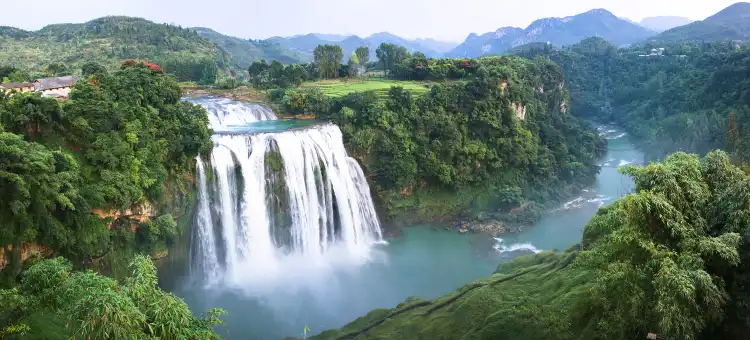
Find the Cheap Anshun Hotels
Enter your dates for the latest hotel rates and availability.
Swipe up to view more
Filter by:
Hotel Star Rating
≤2345
Popular Filters
Amazing 4.5+Great 4.0+Good 3.5+Pleasant 3.0+We found 1226 hotels for you in Anshun
Choose your travel dates to see the latest prices and deals.
Most Booked
Lowest Price
Closest to Downtown
Highest Rated


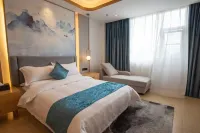
Hotel near Anshunxi Railway Station/Colorful Vientiane Touris,Anshun 2.1% of visitors choose this area
Sswift4444 2022.08.19
There is a free hot spring on the first floor. Although it is a pool of hot water, it is still quite comfortable to soak in it.
Very Good
40 reviews
4.2/5
Price from
BRL 177
per night
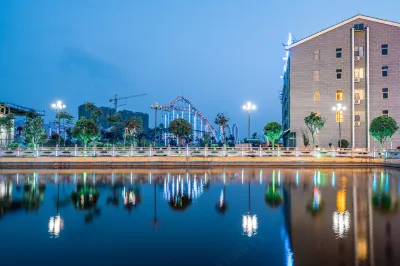
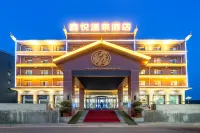

Hotel near Anshunxi Railway Station/Colorful Vientiane Touris,Anshun 2.1% of visitors choose this area
GGuest User 2023.06.23
It was my first time staying in this hotel. The experience was quite good. Parking was convenient, breakfast was rich and varied, the front desk service was very attentive, and anything I needed was always delivered as soon as I called. The housekeepers were also very attentive in cleaning. The mattress and pillows helped with the quality of sleep, which was very good. It is highly recommended. I will come again next time👍👍👍
Excellent
62 reviews
4.4/5
Price from
BRL 176
per night

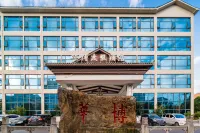

Hotel near Xixiu District,Anshun
MMeitayueyue 2023.10.17
We stayed overnight in Anshun during transit. The hotel was very nice. This hotel receives tour groups every day, and it is really crowded. Having breakfast gave me a feeling of Spring Festival travel. It is recommended not to go too early. Basically, you can have breakfast comfortably at 7:30.
Excellent
231 reviews
4.3/5
Price from
BRL 215
per night

You Might Like
Hotels With BreakfastHotels With Twin RoomHotels With 1 Double BedHotels With Swimming PoolHotels With Free Cancellation

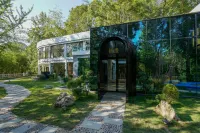
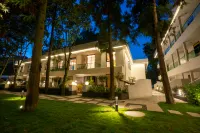
Hotel near Xixiu District,Anshun
YYounishaonianyangjiaoshou 2024.07.25
Living in a homestay has always been a little panicked, because most homestays are very unstable, not as good as hotel standardization.
But this time, there was no problem.
Qiqi, called a homestay or a hotel, no difference
Good service, contact in advance, good communication, this is the first step of excellence. Before arriving, we already had a lot of things clear of the chest and did not panic. After arriving, I quickly came to help carry the box and send it to the room. All things were pointed out in place. Come here is to visit the Dragon Palace, because it is not convenient to buy online, the ticket on the spot also helped us get it, nice
The environment and location are also very good. Just look at the picture. It is similar to the picture. It is still good. If you have time, you can stay for a few more days. At the entrance of the Dragon Palace Scenic Area, you can go in at any time. Anyway, the ticket for the Dragon Palace is available for more than one day. The room is also very big, the same price other places really can't live in such a big, off-season holiday is also a good choice. Exclusively enjoy the large space of 60+, listen to the faint roar of the waterfall in the distance, sit outside the restaurant at night, listen to the cicadas, drink a little wine, wonderful
Outstanding
45 reviews
4.7/5
Price from
BRL 664
per night

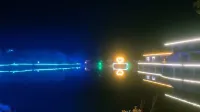

Hotel near Jiuzhou Old Town/Tianlong Fortified Village,Anshun 9.3% of visitors choose this area
ZZhuqiqi 2023.08.11
Very suitable for relaxing homestays -- is located in a quiet countryside. Each room is an independent building, built on the mountain, scattered and hidden between various flowers and trees on the steps. The facilities in the room are simple but practical, clean and hygienic. The staff at the hotel are kind and welcoming, and they try their best to meet our requirements. Quiet tea on the balcony, dinner under the lawn sky, and fishing under the stars are all good memories. From the B&B to the ancient city of Jiuzhou, Yunfeng Bazhai, various attractions are also very close, and there are Langtang and Lijiang River Wetland Park suitable for the whole family to play in the water. In short, we came from Chongqing and spent a happy week here, looking forward to seeing you next time!
Outstanding
25 reviews
4.6/5
Price from
BRL 362
per night


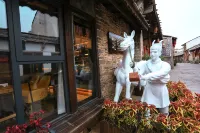
Hotel near Jiuzhou Old Town/Tianlong Fortified Village,Anshun 9.3% of visitors choose this area
Llucecce 2023.05.03
Overall, I am quite satisfied. The facilities are complete and user-friendly. The room is clean and refreshing. The environment is quiet and very suitable for sleeping. The small garden in the leisure area is relatively hidden and the size is just right. It complements the style of the B&B. The communication with the housekeeper is smooth and the service is considerate. Almost everything is answered. ^O^, it would be perfect if breakfast service was restored*^O^*
Outstanding
43 reviews
4.6/5
Price from
BRL 258
per night
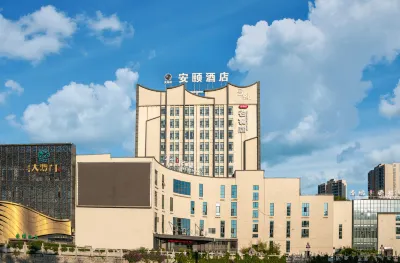

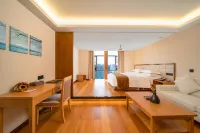
Hotel near Xixiu District,Anshun
GGuest User 2023.10.04
1. My god, such a conscientious hotel didn't raise the price during the National Day.
2. Clean, tidy and sanitary, the bed in the room is very comfortable. It was the most comfortable night I slept in Guizhou these days.
3. The room attendants are warm and polite. I just asked for laundry detergent and they added clothes drying rods and hangers for me. They also took them to dry for me. This kind of service that thinks about the guests.
4. The lady at the front desk also introduced me to the special food of Anshun, which made me feel the taste of home in Anshun.
5. The breakfast in the restaurant is rich. They sit on the fourth floor restaurant platform to watch the sunset. It feels so comfortable.
It is super convenient to go to Huangguoshu. After breakfast, go directly to the highway. Of course, Huangguoshu is also beautiful today. The photos taken are blue sky and clear water.
Excellent
351 reviews
4.5/5
Price from
BRL 185
per night
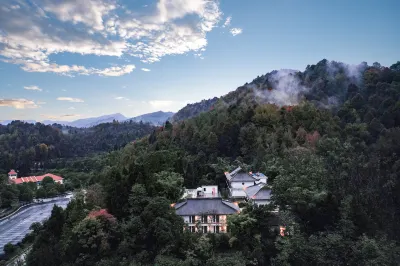

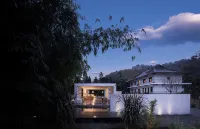
Hotel near Xixiu District,Anshun
GGuest User 2024.01.31
The homestay is next to the scenic spot. In the morning, take the children to the Dragon Palace to take a boat through the cave, and then climb a 2-hour mountain. The scenery and air are quite good, very comfortable! Back to the homestay in the afternoon, the staff has prepared the hot pot for us. Usually the baby does not like fish very much, and their green pepper fish baby likes to eat it. In the evening, the little sister in the store helped us cook milk tea and roast sweet potatoes. With the projection, the baby chose the movie she liked to watch. In the off-season, there are not many people and the atmosphere is very good. Breakfast is also prepared for us with care, the powder is great! The tomatoes are delicious! I like this kind of unhurried travel, and the intimate service of every staff member in the Cuishan Room is even more comfortable.
Outstanding
143 reviews
4.8/5
Price from
BRL 597
per night
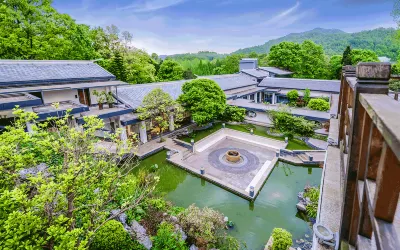
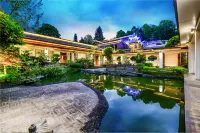
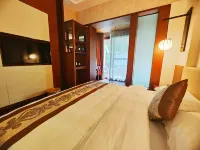
Hotel near Xixiu District,Anshun
GGuest User 2024.09.05
Feeling very cost-effective. Next to the hotel is the entrance of the scenic spot, which is very convenient. Buy tickets online, you don't have to go to the ticketing center (Longzitian). The ticketing center is still quite far from the entrance of the scenic spot, you have to take the scenic sightseeing car to enter. Speaking of the house, more than 800 family rooms, one large bed, two single beds, a hall, and a balcony. After entering the door of the house, the two rooms have separate door cards, which ensures safety and privacy. As for the decoration, after all, there is a certain history, and it cannot be too demanding. Anyway, it is hygienic, clean and comfortable. The hot water is enough and big, I like it. The appearance is as shown in the picture, very beautiful. Overall quite satisfactory.
Excellent
411 reviews
4.4/5
Price from
BRL 96
per night



Hotel near Jiuzhou Old Town/Tianlong Fortified Village,Anshun 9.3% of visitors choose this area
AAaron Cedric 2023.01.30
This hotel gives the guest a warm and personal touch. The best part of the hotel is that the owners are so friendly, treating the guests like family. On the first night I asked for a hot water bottle (热水袋) because I prefer to sleep with that rather than use the AC heating, and the ”mom” of the hotel went out of her way to find me one. On the last day when I was leaving early in the morning before the official breakfast time, she also made sure to give me a prepared breakfast so that I wouldn't be hungry on my day's journey. By the way, the normal breakfast of noodles/mixian is very tasty and nourishing with high quality ingredients. Anyways, the family that runs this hotel really want to make sure you have a comfortable stay, so they are always there to greet you and answer any questions and help you with whatever you need. Even when I asked for clues about where to find batik (蜡染) artists, they found me the phone number of batik artist in a nearby village. They are so eager to help guests squeeze the most out of all of Guizhou's wonders! In my case, as a foreigner and someone who doesn't speak Chinese too well, I found them very patient and helpful.
The rooms of the hotel are really elegant... simple, aesthetically pleasing design. The amenities are all comfortable: the bed mattress was a perfect balance of firm and soft, the shower had high pressure and hot water, etc. The wifi was strong and stable. I should point out that some of the hotel rooms only have a squat toilet, so if you need a seated toilet you should probably contact the hotel in advance to make sure that they have such a room for you before booking.
I should also point out the special location of this hotel. If you, like me, do not have a car and rely on didi or public transportation, then you should know that this hotel is quite a way into the countryside. In fact, on the road to the hotel, the taxi driver asked me, ”Why would you stay in such a remote hotel when there are good hotels in downtown Anshun?” Well, one of the reasons is because I do prefer personal hotels rather than corporate hotels. But also because my primary goal for my stay in Anshun was to see the old garrison villages (屯堡) in the area, not to see other sites like the famous waterfalls. If your goal is to see the old villages, then I think this is the perfect hotel for you. For one reason, one of the original garrison villages is just 5 minutes walk from the hotel. It's little-visited by tourists and so you'll have the whole place to yourself and get really great photographs. That village (called BenZhai [本寨]) is of great historical importance and is very photogenic, and it's so neat to live so close to it. There's another even bigger and more commercialized (and absolutely beautiful) garrison village, also within walking distance (15-20 minutes by walking), called YunShanTun (云山屯). You're also not too far from the most famous villages, namely JiuZhou and Tianlong. Those are at least an hour by walking, so you'll want to get a car. I found it to be nearly impossible to get a Didi driver to accept such rides in this countryside area, but the good news is that the hotel manager found a friendly guy from the village to drive me to those villages and also later to the airport, for the same prices that Didi predicted it would charge. If you do have your own car, then I don't think you have to worry about anything, as this villages in near the highway and thus you can readily access any of the sites of interest in Anshun from this hotel.
Overall, if you are looking for a hotel with warm and human experiences that is near to the places of great historical interest, this is the right hotel for you!
Outstanding
81 reviews
4.8/5
Price from
BRL 171
per night
Top hotel picks in Anshun
See all
Check out these top-booked hotels from the past 30 days!
No.1
4.7/5
2141 reviewHuangguoshu Fengwei Hotel
Hotel near Huangguoshu Waterfalls, Zhenning 100% of visitors choose this area
"Convenient location""Close to scenic area"
Select dates to view pricesNo.2
4.7/5
2855 reviewHuangguoshu Qishouju
Hotel near Huangguoshu Waterfalls, Zhenning 100% of visitors choose this area
"Convenient location""Close to scenic area"
Select dates to view pricesNo.3
4.7/5
4345 reviewMid-Level Hotel
Hotel near Anshun Railway Station/RT-MART, Anshun 25.3% of visitors choose this area
"Great amenities""Delicious breakfast"
Select dates to view pricesNo.4
4.8/5
1255 reviewMeiju Hotel, Anshun West Railway Station
Hotel near Anshunxi Railway Station/Colorful Vientiane Touris, Anshun 2.1% of visitors choose this area
"Great amenities""Easy to get around"
Select dates to view pricesNo.5
4.6/5
452 reviewVienna Hotel Anshun High-speed Railway Station
Hotel near Anshunxi Railway Station/Colorful Vientiane Touris, Anshun 2.1% of visitors choose this area
"Convenient location""Easy to get around"
Select dates to view pricesNo.6
4.6/5
1027 reviewHuangguoshu Mingshengju Hotel
Hotel near Huangguoshu Waterfalls, Zhenning 100% of visitors choose this area
"Offers pick-up/drop-offs""Large rooms"
Select dates to view pricesNo.7
4.6/5
283 reviewHuangguoshu21℃ Hotel
Hotel near Huangguoshu Waterfalls, Zhenning 100% of visitors choose this area
"Convenient location""Close to scenic area"
Select dates to view pricesNo.8
4.5/5
1321 reviewYinhe Holiday Hotel
Hotel near Huangguoshu Waterfalls, Zhenning 100% of visitors choose this area
"Convenient location""Close to scenic area"
Select dates to view pricesNo.9
4.7/5
2330 reviewLavande Hotel (Anshun West High-speed Railway Station)
Hotel near Anshunxi Railway Station/Colorful Vientiane Touris, Anshun 2.1% of visitors choose this area
"Friendly front desk staff""Classy environment"
Select dates to view pricesNo.10
4.8/5
1109 reviewHuangguoshu Waterfalls Yingbin Hotel
Hotel near Huangguoshu Waterfalls, Zhenning 100% of visitors choose this area
"Delicious breakfast""Large rooms"
Select dates to view pricesHotels with tasty breakfast in Anshun
See all
Start your day with a tasty breakfast at one of our favourite hotels in Anshun.
DoubleTree by Hilton Anshun
Hotel near Gufu Street/Nanma Square, Anshun 63.3% of visitors choose this area
Set on the edge of Hong Shan Lake in the city center, DoubleTree by Hilton Hotel Anshun is situated adjacent to the municipal government, and offers easy access to highways, the train station and airport. The Wen Temple of Anshun is within walking distance of our modern hotel in Anshun. Our friendly staffs look forward to greeting you on arrival with a signature, warm chocolate chip cookie.An ideal venue for business and leisure events, the hotel boasts a 1,200 sq. meter ballroom, eight function rooms, a 24-hour connectivity station and the latest A/V technology. In addition, 10 private dining rooms are available where clients and colleagues enjoy Cantonese and Qian cuisine. Admire stunning views over Hongshan Lake or the city through the floor-to-ceiling windows of your guest room. Watch movies on the LCD TV, check emails with Wi-Fi at the large desk, and refresh in the elegant bathroom with a range of amenities. Upgrade to an executive room or suite for exclusive Executive Lounge access, with complimentary breakfast and refreshments.Dine in style at this Anshun hotel, with on-site bars and restaurants offering an extensive variety of cuisines and settings. Start your day with a delicious buffet breakfast in the All-Day Dining Restaurant, and savor local specialties in the sumptuous surroundings of the Chinese Restaurant. Energize in the fitness center, refresh in our heated indoor swimming pool, or indulge in a relaxing spa treatment.
4.6/5
Outstanding1567 reviewPrice per night from: BRL 379
HUANG GUO SHU DUO BEI YUN SHE HOTEL
Hotel near Huangguoshu Waterfalls, Zhenning 100% of visitors choose this area
Duobeiyunshe is located next to the main entrance of Huangguoshu Wetland Park in Huangguoshu Scenic Area, Guizhou Province. It is adjacent to Huangguoshu Scenic Area, only 710 meters away. The hotel is conveniently located, only a 7-minute(2.4km)) drive from the Anshun highway exit, 45 minutes(43km) from Huangguoshu Airport, a 38-minute(38km) drive from Anshun West High-speed Railway Station, and only 15 minutes(11km) from the Balin Bridge.The hotel covers an area of 4,300 square meters and consists of a four-storey single building designed in a step-back style, with 65 rooms that feature independent courtyards and diverse styles. The loft family room is perfect for accommodating up to three generations of your family, while the Yuan Dai and Qiu Chi room types offer you an incredible opportunity to immerse yourself in the stunning surrounding scenery. The hotel's overall design pursues minimalism, with raw concrete and micro-cement as the main materials and cement gray as the main color. The clever use of large hollow bricks creates a dynamic light and shadow effect, contributing to a sense of spaciousness and artistry.All rooms are equipped with smart control systems that supports voice and mobile phone control of room equipment, making it a convenient and tech-friendly living environment. The hotel has an abundance of leisure and entertainment facilities, including a beautiful swimming pool, a restaurant, multiple charming private dining rooms, a music bar, a dedicated indoor play area for children, and even a book bar! Additionally, the hotel provides free services, such as laundry, car wash, and shuttle service to and from Huangguoshu Scenic Area, to ensure your stay is comfortable and hassle-free.
4.9/5
Perfect1304 reviewPrice per night from: BRL 578
Howard Johnson Hot Spring Resort Anshun
Hotel near Anshunxi Railway Station/Colorful Vientiane Touris, Anshun 2.1% of visitors choose this area
The Howard Johnson Hot Spring Resort Anshun is an ideal spot for travelers wanting to discover the city. Visitors to Anshun will find that the Howard Johnson Hot Spring Resort Anshun is a fantastic accommodation choice. The hotel is only 4km from Anshun Huangguoshu Airport and 6km from Anshun West Railway Station, giving guests a number of convenient transportation options. The nearby area boasts an abundance of attractions including Meilan Hot Spring, Anshun Xingwei Laran Art Gallery and Shuangyang Cultural Palace. In their spare time, guests can explore the hotel's surroundings. This Anshun hotel provides parking on site. If you are looking for a convenient place to stay, our guests have told us that this location is excellent. This hotel is particularly popular with those traveling with families.
4.5/5
Excellent291 reviewPrice per night from: BRL 369
Shanyueji Holiday Homestay
Hotel near Huangguoshu Waterfalls, Guanling 100% of visitors choose this area
The Shanyueji Holiday Homestay is one of the newest hotels in Guanling, having opened in 2022. Guanling Railway Station is located approximately 30km away and Anshun Huangguoshu Airport around 56km away. There is no shortage of things to see in the area, with the Yinlianzhuitan Waterfall, Tianxingqiao Scenic Area and Shu Sheng Bu all nearby. At the end of a busy day, travelers can unwind and relax in the hotel or go out and enjoy the city. This Guanling hotel provides parking on site. Guests tell us the location of this hotel is fantastic. For guests traveling with families, this hotel is consistently one of the most popular choices.
4.7/5
Outstanding759 reviewPrice per night from: BRL 334
New Century Hotel Gui'an Guizhou
Hotel near GUI an New District, Anshun
The New Century Hotel Gui'an Guizhou is an ideal spot for travelers wanting to discover the city. Visitors to Anshun will find that the New Century Hotel Gui'an Guizhou is a fantastic accommodation choice. 芦官站 and Guiyang Longdongbao International Airport are located 15km and 57km away respectively. Seeing the sights from this hotel is easy with Anshun's attractions including Forest Star Eco Holiday Park and Yunman Lake International Tourist Resort close by. After a long day of sightseeing, guests can retire to the comfort of the hotel. This Anshun hotel features parking on site. Our guests rate this hotel as one of the best hotels for cleanliness. This hotel is particularly popular with those traveling with families.
4.7/5
Outstanding560 reviewPrice per night from: BRL 302
Guizhou Anshun Huangguoshu Kaiyuan Mingdu Resort Hotel
Hotel near Huangguoshu Waterfalls, Zhenning 100% of visitors choose this area
Guizhou Anshun Huangguoshu Kaiyuan Mingdu Resort Hotel is operated and managed by Dehu Group, a domestic high-end hotel brand ranked 16th in the global hotel group. It is a high-end resort hotel that integrates guest rooms, catering, conferences, and leisure. The hotel is 600 meters away from the Huangguoshu Scenic Area ticket office, 1.3 kilometers away from the Huangguoshu Expressway toll station, 37 kilometers away from Anshun West Station, and only a 30 minute drive away. The hotel has 276 guest rooms, parent-child rooms, private soup rooms, and suites. Each room is equipped with a 65-85 inch LCD large screen TV, and is equipped with full house underfloor heating and central air conditioning. Some rooms are equipped with a large balcony, terrace, terrace private soup, courtyard private soup, and smart toilet. The hotel is equipped with a banquet hall, Chinese private rooms, a la carte restaurant, a full-time buffet restaurant, a gym, an infinity pool, a 10000 square meter outdoor lawn, a chess and card room, KTV, and a children's entertainment area, and other complete service facilities. Whether it is family vacation, business travel accommodation, or various activities, we are your first choice for staying in Huangguoshu Scenic Area.
4.8/5
Outstanding2237 reviewPrice per night from: BRL 388
Anshun Shengfeng Hotel (Gufu Street)
Hotel near Anshun Railway Station/RT-MART, Anshun 25.3% of visitors choose this area
The Anshun Shengfeng Hotel (Gufu Street) is a great choice for guests looking for accommodation in Anshun, having been recently opened in 2021. Traveling to the hotel is easy with Anshun Railway Station located approximately 1km away and Anshun Huangguoshu Airport roughly 8km away. With multiple attractions nearby including Donglinchan Temple, Anshun Confucian Temple and Gushi Former Residence, guests will find plenty to keep themselves occupied. In their spare time, guests can explore the hotel's surroundings. Guests of this Anshun hotel can make use of the parking facilities. According to our guests, this hotel provides a very high level of service. For guests traveling with families, this hotel is consistently one of the most popular choices.
4.5/5
Excellent1370 reviewPrice per night from: BRL 249
Huatong Hotel
Hotel near Xixiu District, Anshun
The Huatong Hotel is an ideal spot for travelers wanting to discover the city. Visitors to Anshun will find that the Huatong Hotel is a fantastic accommodation choice. With Anshun Railway Station just 11km away and Anshun Huangguoshu Airport only 15km away, transportation is very convenient. When guests have some time on their hands they can make use of the onsite facilities. This Anshun hotel provides parking on site. If cleanliness is important to you, this hotel makes an excellent choice, as our guests consider this to be one of the cleanest hotels in the city. This hotel is a popular accommodation for guests traveling with families.
4.6/5
Outstanding484 reviewPrice per night from: BRL 218
Perenc Hotel
Hotel near Anshun Railway Station/RT-MART, Anshun 25.3% of visitors choose this area
The Perenc Hotel is an ideal spot for travelers wanting to discover the city. The Perenc Hotel offers a pleasant stay in Anshun for those traveling for business or leisure. The hotel is only 2km from Anshun Railway Station and 9km from Anshun Huangguoshu Airport, giving guests a number of convenient transportation options. With multiple attractions nearby including Anshun Martial Temple, Gushi Former Residence and Tuobao Mountain Square, guests will find plenty to keep themselves occupied. In their spare time, guests can explore the hotel's surroundings. This Anshun hotel features parking on site. Our guests consider this hotel to have excellent service. This hotel is a popular accommodation for guests traveling with families.
4.6/5
Outstanding1347 reviewPrice per night from: BRL 259
Mountain View Boutique Hotel
Hotel near Huangguoshu Waterfalls, Guanling 100% of visitors choose this area
The Mountain View Boutique Hotel is one of the newest hotels in Guanling, having been renovated in 2022. Guanling Railway Station and Anshun Huangguoshu Airport are located 31km and 52km away respectively. With multiple attractions nearby including Balinghe Bridge, Huangguoshu Beilin Park and Hongya Historic Site, guests will find plenty to keep themselves occupied. At the end of a busy day, travelers can unwind and relax in the hotel or go out and enjoy the city. For those driving themselves, parking is provided on site. Our guests consider this hotel to have excellent service. This hotel is a popular accommodation for guests traveling with families.
4.8/5
Outstanding729 reviewPrice per night from: BRL 938
Explore four-star hotels in Anshun
See all
Whether you're travelling for business or leisure, these 4-star hotels in Anshun provide the perfect backdrop for your journey.
Tunshe·Culture Hotel
Hotel near Anshun Railway Station/RT-MART, Anshun 25.3% of visitors choose this area
The Tunshe·Culture Hotel is an ideal spot for travelers wanting to discover the city. Visitors to Anshun will find that the Tunshe·Culture Hotel is a fantastic accommodation choice. The hotel is conveniently located just 3km from Anshun Railway Station and 10km from Anshun Huangguoshu Airport. With multiple attractions nearby including Donglinchan Temple, Tuobao Mountain Square and Anshun Ancient City Wall, guests will find plenty to keep themselves occupied. At the end of a busy day, travelers can unwind and relax in the hotel or go out and enjoy the city. This Anshun hotel offers parking on site. Our guests consider this hotel to have excellent service. This hotel is particularly popular with those traveling with friends.
4.5/5
Excellent846 reviewPrice per night from: BRL 136
Tianjiao Resort Hotel
Hotel near Huangguoshu Waterfalls, Zhenning 100% of visitors choose this area
The Tianjiao Resort Hotel provides a great place for travelers to relax after a busy day. The Tianjiao Resort Hotel is an ideal choice for travelers who want to take in the sights and sounds of Zhenning. Guanling Railway Station and Anshun Huangguoshu Airport are located 28km and 43km away respectively. There is no shortage of things to see in the area, with the Flying over Huangguoshu-360 Jixian Feiqiu, Shitou Village and Huangguoshu Waterfall all nearby. In their spare time, guests can explore the hotel's surroundings. This Zhenning hotel provides parking on site. According to our guests, this hotel provides a very high level of service. This hotel is a popular accommodation for guests traveling with families.
4.7/5
Outstanding1113 reviewPrice per night from: BRL 173
Mingyuexin Hotel
Hotel near Guanling
I went to Guanling on a business trip and stayed for four days. This hotel was a pleasant surprise. The room was spacious, the facilities were new, the breakfast was delicious, the service was very good, and there were fruits in the evening. In short, the price-performance ratio was high. I especially recommend the garden room, which is spacious and has a leisure area.
4.7/5
Outstanding259 reviewPrice per night from: BRL 143
Huangguoshu Hantun Hotel
Hotel near Huangguoshu Waterfalls, Zhenning 100% of visitors choose this area
1. Undeniably, the location is very good! Opposite the sightseeing bus point! Very convenient, also accept storage!
2. But the air conditioner sound is super loud, but the temperature will stop immediately when it is low, like a world away, it will suddenly get up again, the sound is super loud!
3. Breakfast should be included in the room rate, very simple, mainly buns, eggs, sweet potatoes + potatoes? + rice noodles.
Overall, it is definitely not particularly good, especially the sound of the air conditioner, the sleep is particularly poor, it is recommended to ask which room the air conditioner sound is smaller ~
4.5/5
Excellent219 reviewPrice per night from: BRL 231
黃果樹山生三舍民宿
Hotel near Huangguoshu Waterfalls, Zhenning 100% of visitors choose this area
5天4晚的貴州行,住了4家不同的酒店,這家最滿意,強烈推薦。服務超級好,小姐姐小哥哥都好熱心,主動送我們去景點,晚上吃過飯,又來吃飯的地方接我們;房間有點小,但是麻雀雖小,五臟俱全,房間收拾的很乾凈,床也蠻舒服的,但是因為我們是3個人,所以1.2米的床相對2個人有點小;陽台蠻大的,坐在外面看看風景聊聊天,喝個小酒超舒服;早飯很豐盛,中西都有,小點心超好吃,粉面也好吃,牛肉給了好多片;小朋友最喜歡他家的游泳池,一來就玩上了,就是水有點涼。他們家浴袍超舒服,絕對超五星級酒店。
4.8/5
Outstanding291 reviewPrice per night from: BRL 305
Manglan Hotel (Huangguoshu Scenic Area Tourist Center Store)
Hotel near Huangguoshu Waterfalls, Zhenning 100% of visitors choose this area
The Manglan Hotel (Huangguoshu Scenic Area Tourist Center Store) is an ideal spot for travelers wanting to discover the city. The Manglan Hotel (Huangguoshu Scenic Area Tourist Center Store) offers a pleasant stay in Zhenning for those traveling for business or leisure. Guanling Railway Station and Anshun Huangguoshu Airport are located 28km and 43km away respectively. This hotel is located near many of Zhenning's attractions including Huangguoshu National Park, Flying over Huangguoshu-360 Jixian Feiqiu and Monument of Eighty-one Sufferings. In their spare time, guests can explore the hotel's surroundings. Guests of this Zhenning hotel can make use of the parking facilities. Germaphobes can rest easy - the level of cleanliness is highly rated at this hotel. This hotel is particularly popular with those traveling with families.
4.6/5
Outstanding2022 reviewPrice per night from: BRL 250
Shan Yue Ji Mu Ye Fairy Tale Homestay
Hotel near Huangguoshu Waterfalls, Zhenning 100% of visitors choose this area
Hotel location is good, Huangguoshu Expressway is 3 minutes to the parking lot without charge, the whole park is very clean and comfortable, the forest is really beautiful to take pictures, there are batiks and shootings, the room is beautifully arranged, small animals, many big animals, suitable for children, carriages, trains, Adults can fish, there is a river, the water is clean, the service is warm and thoughtful, the breakfast is prepared to be delivered to the room is very intimate, it is recommended to stay for one more day, one day is not enough to play!
4.6/5
Outstanding133 reviewPrice per night from: BRL 285
麓格民宿
Hotel near Huangguoshu Waterfalls, Guanling 100% of visitors choose this area
In the picturesque resort, there is a charming homestay that fascinates people. Here, it is not only a place for you to rest during the journey, but also a romantic trip of encountering nature and delicious food.
The homestay has a stunning open-air swimming pool. The clear pool water is glittering in the sunlight, allowing you to swim freely and enjoy the coolness and comfort. The barbecue area is an excellent place for friends and relatives to gather. The warmth of the charcoal fire and the aroma of the food are intertwined, creating a joyful atmosphere. The terrace rest area is an ideal place for you to relax your body and mind. Here, you can overlook the surrounding beautiful scenery, feel the gentle breeze, and let your soul get a moment of tranquility.
The geographical location is unique. It is only 2.5 kilometers away from the ticket window of the Huangguoshu Waterfall Scenic Area, allowing you to easily appreciate the magnificent wonders of nature. It is 1 kilometer away from the Huangguoshu Wetland Park. Walk in it and feel the beauty of the ecology. It is 4 kilometers away from the Shitouzhai Batik Town, where you can experience the traditional batik craftsmanship and feel the charm of ethnic culture. It is 1.5 kilometers away from the Shenlong Cave Scenic Area to explore the mysterious underground world. In addition, there is a food street right next to the homestay, with various local specialties dazzling, allowing your taste buds to bloom to the fullest.
The homestay is also equipped with a private parking lot to facilitate your travel. Here, you can enjoy a comfortable accommodation environment to the fullest, feel the charm of nature, taste the local food, and leave unforgettable memories of your journey. Come here quickly and start your dream trip!
4.6/5
Outstanding69 reviewPrice per night from: BRL 279
Qingshan Boutique Hostel
Hotel near Huangguoshu Waterfalls, Guanling 100% of visitors choose this area
The Qingshan Boutique Hostel is an ideal spot for travelers wanting to discover the city. The Qingshan Boutique Hostel is an ideal choice for travelers who want to take in the sights and sounds of Guanling. Guanling Railway Station is located approximately 31km away while Anshun Huangguoshu Airport is 55km away. Seeing Guanling's sights from this hotel is easy with Balinghe Bridge, Rhino Lake and Bolian Hotels&Spa all close by. When guests have some time on their hands they can make use of the onsite facilities. This Guanling hotel provides parking on site. According to our guests, this hotel provides a very high level of service. For guests traveling with families, this hotel is consistently one of the most popular choices.
4.6/5
Outstanding253 reviewPrice per night from: BRL 564
Junyi Hotel (Ziyun New Town)
Hotel near Ziyun
The hotel is in a good location. There is a parking lot (above and underground). The service staff is very enthusiastic. There are many kinds of breakfast. The room is dry and wet (the bath and toilet are separate). The disadvantage is that the hot water needs to be left for a long time before there is hot water. . There was also an incident in the accommodation. I booked a deluxe twin bed (there is no room for superior twin beds). The manager asked the waiter to upgrade it to an elegant twin bed for free. After moving in, I found that the smell was unpleasant to the eyes of adults and asked to change rooms. The waiter readily agreed. , it just said that the deluxe twin bed was no longer available, and there was a superior twin bed that had just been cleaned, so I could only accept it. After all the trouble, the room was not upgraded and was downgraded. Fortunately, this superior twin bed was not bad.
4.7/5
Outstanding225 reviewPrice per night from: BRL 186
Latest Reviews for Anshun hotels
See all
Explore genuine reviews and ratings from real travellers to find the perfect accommodation for your needs.
4.9/5
Perfect
CClem + Ant1Located in the center of a beautiful ancient village, I was born art hotel is a cute traditional local house. The owners are very helpful and kind. Breakfast isn’t included but we had a delicious bowl of wontons in their small restaurant.
Room was very clean and has a projector if you want to watch movies or tv shows on youku (can easily find english ones).
Highly recommend staying there !
Best value for money !
The village is worth your time, with locals in costume re-playing an ancient wedding and masked fighters. Well done and not too kitch. Villagers were very welcoming.
Also highly recommend a short climb to the temple on top of the mountain.
Wusheng Yisu (Yunfeng Tunbao Scenic Area)
Hotel near Jiuzhou Old Town/Tianlong Fortified Village, Anshun 9.3% of visitors choose this area
Price per night from: BRL 138
4.8/5
Outstanding
FFloraJPPClouds roll and roll☁️Fog gathers and disperses
Feel the four seasons in the mountains, feel the diversity of Yaojia
When I first arrived, the hotel was shrouded in fog~ Although I was a little scared that I couldn’t see the mountain scenery~ But it was like entering a fairyland
The weather changed quickly~ The next day, I could see the Ba Ling Bridge and the Dishuitan Waterfall when I opened the window~ The scenery was excellent
A very satisfactory accommodation experience, thank ”Butler Xiao Pang” for his thoughtful service, running around for us, and responding to our requests~ Very nice~ Recommended!
Yaojia Wangpu Homestay
Hotel near Huangguoshu Waterfalls, Guanling 100% of visitors choose this area
Price per night from: BRL 1150
4.8/5
Outstanding
GGuest UserThe room was very new. I originally wanted to stay for one day, but unfortunately there were no rooms in the hotel, so I had to check out and change to another hotel. The landlady gave snacks to the children, which was very considerate. The hotel is in a convenient location and parking is convenient. There is a small alley near the hotel, which the children like. There are quite a lot of places to eat around, the room has a projector, and the boss also opened a VIP. I have stayed in more than 10 B&B hotels from Hangzhou to Anshun, and this boss is the only one who has not hinted that he wants good reviews. But a good fight must be given. Really worth it. .
YONGTANG HOTEL
Hotel near Anshunxi Railway Station/Colorful Vientiane Touris, Anshun 2.1% of visitors choose this area
Price per night from: BRL 101
4.7/5
Outstanding
BBingruojiaohanpaidaxinVery good accommodation experience, the room is clean, spacious and well-equipped, the service is very good, they will help to pick up and drop off at the scenic spot, although it is very close. It takes only 5 minutes to walk to the entrance of the waterfall. The ecological environment here is also great, there are large lawn lounge chairs, which is very suitable for parents and children to come and play. In addition, it can provide 24-hour free laundry function, just want to stay a few more days. The breakfast is rich with both Chinese and Western food. The red sour soup beef hot pot ordered in the evening is also very delicious and authentic. Highly recommended to stay~~~
Huangguoshu Yuanjian Homestay
Hotel near Huangguoshu Waterfalls, Zhenning 100% of visitors choose this area
Price per night from: BRL 476
4.5/5
Excellent
GGuest UserThe room is clean and hygienic, with complete facilities and good service. It is very convenient for traveling, shopping and eating. There are various snack bars, stir-fry restaurants and dumpling shops in the surrounding area. The bus station is in front of the hotel. The tourist distribution center is dozens of meters away, which is suitable for shelter. Department of travel and business trip services.
ymjd
Hotel near Anshun Railway Station/RT-MART, Anshun 25.3% of visitors choose this area
Price per night from: BRL 103
4.5/5
Excellent
GGuest UserThe hotel is in a great location - there are bus stops directly outside, which makes getting to/ from the bus station and high-speed train station quite convenient. It's only about a 10-15 minute walk to Hongshan lake. There are lots of little shops in the neighborhood, and a few street food stalls up towards the lake. The hotel staff are very friendly and helpful; one very patient member of staff spent a long time helping me find information about Huangguoshu falls, and gave useful advice about getting the bus there. The room is spacious and very clean. It even has a cubicle for the shower. Very good value for money.
Anshun Pusu Boutique Hotel (Xixiu Hongshan Lake Branch)
Hotel near Gufu Street/Nanma Square, Anshun 63.3% of visitors choose this area
Price per night from: BRL 96
4.5/5
Excellent
GGuest UserThe hotel is very distinctive. The lady at the front desk is very enthusiastic and patiently answered my questions. The room is clean and tidy, very quiet. It is very suitable for a good rest after a trip. I will continue to choose this hotel next time I come here.
I Do Art Hotel
Hotel near Huangguoshu Waterfalls, Guanling 100% of visitors choose this area
Price per night from: BRL 175
4.4/5
Excellent
GGuest UserThe room is spacious, hygienic and clean, the mattress is good, sleeping comfortably, the price is affordable and breakfast is included, there is also a free washing machine, and free parking is convenient for travel. After dinner, if you have nothing to do, you can go for a walk by the small river behind the hotel. Recommended.
Sunshine Flower Holiday Hotel
Hotel near Anshun Railway Station/RT-MART, Anshun 25.3% of visitors choose this area
Price per night from: BRL 125
4.3/5
Excellent
GGuest UserThe hotel is located approximately 4 km from the station (High Speed Railway West Station). The hotel description stated that the shuttle to the station was free, which we took advantage of. On the day of arrival, she met us with a sign (at the hotel in Guilin they asked us to call here and tell them to pick us up - for some reason hotels don’t have mail, they communicate by calling). The area where the hotel is located is not on the map yet! and there is already a complex of newly built buildings and an almost completed amusement park across the road.
The hotel occupies the second floor of a high-rise building, it was quiet because the rooms face the courtyard. On the ground floors of the surrounding buildings there are already shops and restaurants, you can find food. The room is spacious, but the air conditioning warms up quite quickly. There is a kitchen, but apart from a kettle and cups, there are no dishes (you probably have to ask for it separately for a fee). The breakfast is decent, many thanks to the cook.
Taililai Hotel (Anshun High Speed Railway West Station)
Hotel near Anshunxi Railway Station/Colorful Vientiane Touris, Anshun 2.1% of visitors choose this area
Price per night from: BRL 110
4.3/5
Excellent
GGuest UserDuring this trip to Guizhou, I had the honor of staying at Huangguoshu Sotelai Hotel, which undoubtedly set a new benchmark for my accommodation experience during the trip. From the environment to the service, every detail amazed me, and I am willing to share this wonderful memory with you. The location of the hotel is very unique. It is located near the famous Huangguoshu Waterfall Scenic Area, surrounded by green trees and fresh air, as if you are in the embrace of nature. The design of the hotel shows a fashionable atmosphere without losing warmth and elegance. The lobby is spacious and bright, beautifully decorated, and full of artistic atmosphere. The hotel staff is very professional and enthusiastic. From the first time I stepped into the hotel, every staff member greeted me with a smile and took the initiative to help, which made me feel very considerate. Whether it is luggage handling, room arrangement or travel consultation, their service is very thoughtful. My room has a comfortable bed and warm color matching, creating a peaceful atmosphere. The room is fully equipped with facilities, including high-speed Internet, to ensure that my living experience is comfortable and convenient. Standing by the window and looking out, I can also enjoy the natural beauty around me. Such an accommodation experience is undoubtedly unforgettable. The hotel's breakfast is also worthy of praise, with rich and varied dishes and international flavors. The ingredients are fresh and the taste is pure, and every meal is a delicious journey. In short, Huangguoshu Sotel Hotel is a high-quality accommodation that combines natural scenery with modern comfort. Whether it is a vacationer seeking relaxation or a tourist who wants to explore the local culture, you can find a satisfactory answer here. It is highly recommended to friends who plan to visit Huangguoshu, and the hotel you bring will definitely add a lot of color to your journey!
Sotel Literature and hotel
Hotel near Huangguoshu Waterfalls, Guanling 100% of visitors choose this area
Price per night from: BRL 135
What travellers say about Anshun attractions
Discover these places worth visiting in Anshun and select a hotel nearby for ultimate convenience
Huangguoshu Waterfall
EE38***92Huangguoshu Waterfall is 77.8 meters high and 10.1 meters wide. You can hear the roar of the waterfall from a distance. The Doupotang Scenic Area is the filming location of Journey to the West. The Silver Chain Falling Pond is extraordinary and you can feel the shock of the waterfall up close.
Loong Palace Scenic Area
寻寻找未知角度Because we went to Zhijin Cave first and then to Dragon Palace, and Zhijin Cave is so spectacular and amazing, so when we saw Dragon Palace, we felt that it was quite different. Our expectations were a bit too high and we were also very disappointed. But in the scenic area, we met a lot of tourists and interviewed many guests who said that Dragon Palace was stunning and beautiful. Because they had not been to Zhijin Cave yet, they all agreed that Dragon Palace was very beautiful. So we suggest that tourists should go to Dragon Palace first and then to Zhijin Cave in the future so that they will not feel so disappointed. We went the other way around and saw the most beautiful one first, so the others were not to our liking!
Doupotang Waterfall
粉粉红色的猴Steep slope pond waterfall is the familiar 1986 version of "Journey to the West" film tail song "Dare to ask where the road is" filming place, the scene of Tang monks and apprentices walking by the horse is filmed here.
Ziyun Getu River Scenic Spot
2205***35Overall it's OK, there is a Spiderman show and a Miao village show, the location is relatively remote, although it is a four-star scenic spot, but compared with other attractions in Guizhou, there are very few people. It is more suitable for self-driving tours.
Water Curtain Cave
郭郭润龙浪迹天涯20230512 Full day:
1. "Water Curtain Cave" is located in the 5A scenic spot "Wuyi Mountain". Wuyi Mountain is a world-famous tourist destination, with the dual titles of World Natural and Cultural Heritage and World Cultural Heritage. It has a typical Danxia landform, picturesque scenery, and a high forest coverage rate. It is the location of the six mother trees of the famous "Dahongpao" in Wuyi rock tea. Birds, beasts, pheasants and fish can be seen everywhere in the mountains. It is a holy place for health preservation. In terms of humanities, there are many temples and Taoist temples since the Qin and Han Dynasties, and there are more than 450 existing stone carvings. In history, there are footprints of celebrities such as Zhu Xi, Xin Qiji, Lu You, Li Shangyin, Xu Xiake, and Sa Zhenbing. The core scenic spots that have been developed in Wuyi Mountain are divided into four major areas: "Tianyou Peak-Jiuquxi (bamboo raft)-Wuyi Palace", "Huxiaoyan-Yixiantian", "Dahongpao", and "Water Curtain Cave".
①Address: Yingbin Road, Wuyishan City, Nanping City, Fujian Province.
② Transportation: Direct bus access, easy parking by car.
③ Peak season: Each season has its own attractions, green leaves in spring and summer; red leaves in autumn; snow in winter.
④ Time: 2-3 days.
⑤ Notes: Wuyishan City has introduced a new policy, free tickets in 2023 (shuttle bus fare is not free), and free city buses. If you want to be free of tickets during normal hours, you can enter the mountain in the early morning and will be regarded as a citizen doing morning exercises.
2. There are 3 types of shuttle bus tickets: 1 day, 2 days, and 3 days, the ticket prices are 70, 85, and 95 yuan respectively. If you want to play in the 4 major areas, 1 day is too tight, 2 days are just right, and 3 days will be very sufficient, and you can walk through all the small landscapes and paths.
3. The Water Curtain Cave is not a cave in the true sense. It is a tall and spacious semi-open stone cave. It is named because the water flows down from the top of the rock. The "Three Sages Temple" in the cave was built in the 17th year of Shaoxing in the Southern Song Dynasty (1147), formerly known as "Pingshan Xiansheng Temple". It originally enshrined Liu Zihui, a Neo-Confucian philosopher and Duke of Qi in the Southern Song Dynasty. During the Jiatai period of the Song Dynasty (1201-1204), Liu Zihui's disciples Zhu Xi and Liu Fu were added to the temple and the name was changed to Three Sages Temple. After that, it was rebuilt and destroyed several times. The current building was rebuilt in the 12th year of the Republic of China (1923). The plaque in the hall was inscribed by Zhu Xi. There are building ruins and inscriptions all around the temple. On the west side is the exit, and on the east side is a wild road leading to the cliff tombs and grottoes.
Jiuzhou Old Town
导导游小加Free attractions, worth checking in! Jiuzhou Ancient Town is a famous historical and cultural town in Jingxi. The ancient buildings in the town are well preserved, and there are many shops on both sides of the street, which is full of strong historical atmosphere. Here, you can feel the ancient customs and simple folk customs of Jingxi.
Millennium Buyi Ancient Village
爱爱旅游的小小丹🪵The village also has a Bouyei folk exhibition hall with rich collections. You can also experience Bouyei batik by yourself. It is very suitable for children to experience. 🪨 Gaodang Village still preserves the military defense castle of the Ming Dynasty. The small village in the east and the Datun Fort behind the village are all ancient offensive and defensive facilities for guarding the village and resisting the enemy. 🌿Walk on the wooden trestle at the other end of the village. You can see the distant mountains and rice fields of the "Stone City". It is as beautiful as a painting. This is really a treasure paradise!
Tianxingqiao Scenic Area
果果汁分你一半✔Tianxing Bridge Scenic Area is located 7 kilometers downstream of Huangguoshu Waterfall. It is mainly used to appreciate the wonderful combination of stone, tree and water. It is a natural bonsai area formed by the transformation of the stone forest on the water. If the characteristics of Huangguoshu Waterfall are majestic, the Tianxing Bridge area is exquisite and beautiful. The couplet "Wind knife and water sword carve the bonsai of ten thousand acres, root pen and vine ink draw the eternal painting" summarizes the charm of Tianxing Bridge Scenic Area. There are three connected areas here, namely Tianxing Bonsai Area, Tianxing Cave Scenic Area, and Water Stone Forest Area.
Tianxing Bridge Scenic Area can be divided into stone scenery, water scenery, tree scenery, and cave scenery. In fact, they cannot be separated because they are integrated with each other, and this integration is not only the integration of form, but more importantly, the integration of spirituality. Tianxing Bridge is the most spiritual place. The mountains are spiritual, the water is spiritual, the trees are spiritual, and even the stones are spiritual.
Shitou Village
粉粉红色的猴The stone houses are durable and sturdy without the need for a single brick or tile. In the Stone Village, all the stone houses are stacked up layer by layer, built against the mountain, with an orderly layout. The passages in the village and the small bridge in front of the village are all built with stones. When you come here, it feels like you have entered a stone kingdom.
FAQs About Hotels in Anshun
How do I book a hotel on Trip.com?
To book a hotel on Trip.com, simply enter your destination, travel dates, and the number of guests on the page. Then, browse through the available hotels and select the one you want to book. Follow the prompts to enter your payment information and complete the booking.
How do I get hotel deals on Trip.com?
There are several ways to find affordable hotels on Trip.com. You can narrow down your search results by filtering hotels according to your preferred price range, or you can sort the results by price to view the cheapest options first.
Where can I find hotel deals on Trip.com?
Trip.com offers a wide variety of hotel deals and promotions that are available throughout the year. You can easily find these special offers on our deals page. What's more, if you are a member of our loyalty program, you can sign in to your account and discover exclusive discounted rates at hotel list pages.
How can I get lower prices for hotels?
Sometimes booking hotels midweek is cheaper, but it also depends on the season.
How many hotels are listed on Trip.com?
You can find over 5 million hotels in more than 230 countries or regions on Trip.com. Haven't decided which hotel to book? Browse our site to get ideas!
Can I cancel or change my hotel bookings on Trip.com?
It depends on the hotel policy and date of cancellation. Please check the policy section of the related hotel pages. To cancel or change your bookings, sign in to your Trip.com account, go to "My Bookings", and follow the instructions.
How do I contact Trip.com customer support?
You can contact Trip.com's 24/7 customer support by visiting the Help Center on Trip.com and submitting a request. You can also contact us by phone or service chat, depending on your location.
Local Travel Info
| Highest Price | BRL 1,213 |
|---|---|
| Lowest Price | BRL 45 |
| Number of Reviews | 151,707 |
| Number of Hotels | 2,484 |
| Average Price (Weekdays) | BRL 239 |
| Average Price (Weekends) | BRL 240 |
Keep Exploring
Hotels Near Attractions
More Accommodation Types
Family-friendly Hotels in AnshunPet friendly Hotels in AnshunHot spring Hotels in AnshunRomantic Hotels in AnshunHotels in Anshun With GymsHotels in Anshun With Swimming PoolsHotels in Anshun With Wi-FiHotels in Anshun With SpasHotels in Anshun With BarsAnshun VillasAnshun InnsAnshun Homestays2-Star Hotels in Anshun3-Star Hotels in Anshun4-Star Hotels in Anshun5-Star Hotels in AnshunHoliday Inn Express Hotels in Anshunhuayijiudian Hotels in AnshunJI Hotel Hotels in AnshunEcheng Hotels in AnshunSTARWAY Hotels in Anshun
Most Viewed Hotels
Flights from Popular Cities
Karachi to Islamabad FlightsKarachi to Lahore FlightsIslamabad to Karachi FlightsLahore to Karachi FlightsIslamabad to Skardu FlightsLondon to Lahore FlightsLahore to Islamabad FlightsKarachi to Multan FlightsKarachi to Skardu FlightsKarachi to Peshawar FlightsPeshawar to Karachi FlightsManchester to Islamabad FlightsIslamabad to Lahore FlightsDubai to Lahore FlightsIslamabad to Saidu Sharif FlightsKarachi to Dera Ghazi Khan FlightsQuetta to Bahawalpur FlightsGilgit to Karachi FlightsChitral to Islamabad FlightsGwadar to Lahore FlightsGwadar to Karachi FlightsIslamabad to Sialkot FlightsSkardu to Karachi FlightsKarachi to Quetta FlightsLahore to Multan FlightsLahore to Gwadar Flights